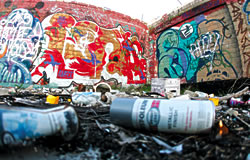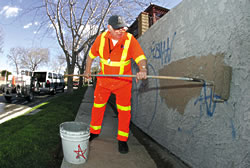FAMILY - FAMILY FEATURES
Increase of Graffiti a Sore Sight for Santa Clarita
City and Local Volunteers Work to Eradicate Problem
May, 2005 - Issue #7
 |
It seems to pop up overnight. Usually black and angular, the markings are scrawled on walls, homes, utility boxes, and even trees, much to the dismay of the neighborhood. Graffiti, or tagging, is a message left by gang members or a bored teen that says, "This is my area -look at me."
The Santa Clarita Valley Pride Committee has been dedicated to keeping out crime and eradicating graffiti since 1988. Four years ago, the City of Santa Clarita stepped in to help.
"We really need the community's help to get rid of graffiti," said Dianna Boone, community services administrator for the city. "We can't let (the taggers) think they are winning."
"Graffiti has been in particular areas of the community, but last year it spread," she said.
The term "graffiti" comes from the Greek word graphein which means "to write." Graffiti today ranges from simple, one-color monikers (like a nickname) called "tags" to multi-colored compositions. According to Graffiti Hurts - Care for Your Community®, graffiti sends a message that no one cares. And it inarguably attracts crime.
The most effective way to prevent graffiti is to remove it immediately. Sometimes this is a difficult task, but studies show that if graffiti is removed within 24- to 48-hours, there is usually no reoccurrence in that spot.
Graffiti drains tax dollars that could be used for schools, roads, parks and other community improvements. The city of Los Angeles, for example, spent $55 million in 2002 for graffiti removal. The Santa Clarita City Council allocated $20,000 on supplies and equipment for graffiti removal last year and hired a part-time staff member to help with volunteers.
Boone said the Pride Committee volunteers have probably saved the city more than $200,000 a year in total graffiti eradication costs because they donate their time.
"We are already ahead of most cities because of the Pride Committee," Boone said. "They make a big difference. These people are really motivated and all of us receive a blessing because of what they do."
 |
Gang graffiti is quite different. Markings by gangs are used to recruit members, advertise drugs for sale or as a warning to other gangs. When a gang marking is X'd out, that is perceived as a challenge.
Gang activity in Santa Clarita is growing, said Detective Dan Finn, a member of the sheriff's department COBRA unit, a prevention detail aimed at juvenile and gang activity.
"As the city grows, so do gangs," Finn said. "Schools get bigger and gangs get bigger."
While Latin American gangs, such as the Newhall 13, have been around for many years, Finn said the newer gangs are multi-racial. Crimes, such as vehicle burglaries and assault cases, are many times attributed to gang members, but there have also been several murders over the past few years which Finn said are also gang related.
Gangs have to create an atmosphere of fear and intimidation. When gang members scrawl graffiti in a particular area, they are trying to gain control, Finn said.
"If they get control of that area, they now consider it their territory and crime will increase," he said.
While Pride Committee members make a valiant effort to clean off graffiti as quickly as possible, Boone said she knows there are other community members who take it upon themselves, grab some rags and paint and remove graffiti. Saugus resident Mark Siezega is one of those individuals. He said he found graffiti near his home and was angry.
"I've decided to start going out at least one or two mornings a month," Siezega said. "I find (graffiti) so disrespectful and such an eyesore. These taggers have the intellect of dogs marking their neighborhood. It's as if they enjoy living in their own waste and it's a real sign of ignorance."
Siezega said he usually paints the walls on San Fernando Road. It doesn't take that long to wipe out the graffiti, and he gets a certain amount of satisfaction when he realizes it takes him less time to paint over the graffiti than it took the tagger to paint it.
There are those who consider graffiti an art form and as such, some tagger's creations are turning up on snowboards and skateboards. Boone, an advocate of art, would much rather see snowboards than walls covered in graffiti.
"I love to encourage art and everybody has the right of freedom of expression," she said. "It just shouldn't infringe on other's rights."
The city is offering $500 for the arrest and conviction of taggers. If they are caught, they will be charged with a felony for any damage over $400. Residents should call the sheriff's department at 255-1121 to report these crimes. Those interested in volunteering can call 25-CLEAN.
|
||||||||||||||||||||||||||||




